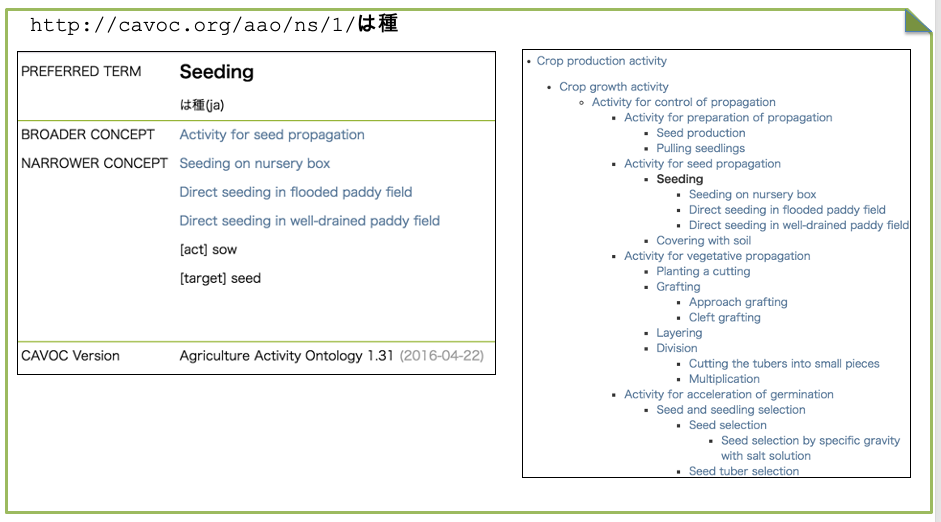 |
Semantics of Tabular Data
|
 |
Enhancing the reusability of data raises the value of the data. Since tabular data is widely used in both academia and business, it is important to enhance the reusability of tabular data. The purpose of this project is to realize semantic annotation of tabular data using Semantic Web technology to enhance the reusability of tabular data.
Semantic annotation is realized as mappings of individual items in the data to nodes in a Knowledge Graph. We generate the Knowledge Graph consisting of entities and properties from Wikipedia/DBpedia/WikiData, and map arbitrary tabular data to this Knowledge Graph.
The results of this project have won the ISWC SemTab Challeges in 2019 and 2020.
Recent Publications:
- P. Nguyen, I. Yamada, N. Kertkeidkachorn, R. Ichise and H. Takeda: MTab4Wikidata at SemTab 2020: Tabular Data Annotation with Wikidata E. Jiménez-Ruiz, O. Hassanzadeh, V. Efthymiou, J. Chen, K. Srinivas and V. Cutrona eds., Proceedings of the Semantic Web Challenge on Tabular Data to Knowledge Graph Matching (SemTab 2020) co-located with the 19th International Semantic Web Conference (ISWC 2020), Virtual conference (originally planned to be in Athens, Greece), November 5, 2020, Vol. 2775 of CEUR Workshop Proceedings, pp. 86-95, CEUR-WS.org (2020).
- 1st Prize, Semantic Web Challenge on Tabular Data to Knowledge Graph Matching (CEA, CTA and CPA Tasks), ISWC2020, MTab4Wikidata Team (Phuc Nguyen, Ikuya Yamada, Natthawut Kertkeidkachorn, Ryutaro Ichise, Hideaki Takeda
|
Agricultural Vocabulary Project
|
 |
In this project, we are using Semantic Web technology to systematize the vocabulary of the agricultural field. Information technology is rapidly introducing the agricultural domain, and it is necessary to incorporate agricultural knowledge and experience into the information systems appropriately. In this project, we adopt Semantic Web technology to systematize the terminology around these concepts by extracting the underlying concepts in the domain. This makes it easier for computers to process the information while representing the knowledge appropriately in the field.
So far, we have developed and released the Agricultural Activity Ontology (AAO) which describes agricultural work systematically, the Crop Vocabulary (CVO) which covers the basic agricultural products in product and circulation, and the Cow Feed Vocabulary (CFO) which describes cattle feed in uniformly.
Recent Publications:
- A. Takezaki, S. Joo, H. Takeda and T. Yoshida: Common Agriculture Vocabulary for Enhancing Semantic-level Interoperability in Japan, Japan Agricultural Research Quarterly: JARQ, Vol. 54, No. 3, pp. 219-225 (2020).
|
|
Development of the Knowledge Representation Language for Engineering Problem Solving
|
 |
The diverse knowledge possessed by engineers appears in their activities in the field of design and production. In this project, we will develop the knowledge representation language to describe the problem solving process by engineers. Based on the Digital Triplet (D3) concept, this language models the engineer's activities as chains of actions in three layers: knowledge, information, and physics, and describes the chains in the notation based on IDEF0. By describing engineering problem solving based on this language, the problem solving process can be made explicit, verified, automatically executed, and systemically linked.
|
|
Research on Scholarly Communication
|
 |
Open Science is becoming a new form of science in the era of the Internet. Scholarly communication is to be adapted to Open Science where various forms and processes of communication are needed. We are investigating scholarly communication in the aspect of computer science, in particular, artificial intelligence.
Recent Publication:
- Y. Minamiyama, U. Ikeuchi, K. Ueshima, N. Okayama and H. Takeda: Investigation and Development of the Workflow to Clarify Conditions of Use for Research Data Publishing in Japan, Data Science Journal, Vol. 19, No. 1, p. 53 (2020).
|
|
|
|
|
|